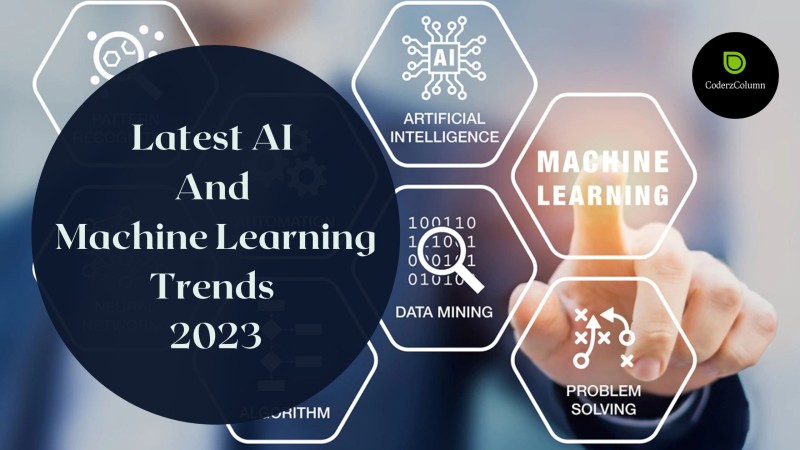
Latest AI And Machine Learning Trends 2023¶
Artificial Intelligence (AI) has made tremendous progress in recent years, with AI models achieving and sometimes surpassing human-level performance in various tasks such as image classification, natural language processing, and game playing. These advances have been made possible due to the availability of large amounts of data, powerful hardware, and the development of new algorithms and architectures.
Some of the latest AI models that have received significant attention in the research community and industry include Generative Adversarial Networks (GANs), Transformers, and Reinforcement Learning algorithms. These models have been applied to a wide range of applications, from creating realistic images and videos to improving decision-making in complex environments. Despite their success, there is still much to be done to make AI more robust, trustworthy, and explainable, and to extend its capabilities to more domains.
Table Of Content¶
Explain The AI and Machine Learning Trends For 2023?
- Explainable AI (XAI)
- Edge AI
- Federated Learning
- Multi-modal AI
- Reinforcement Learning
- Automated Machine Learning (AutoML)
- AI-enabled Conceptual Design
Give Examples of the Best AI Models Trending in 2023
- Transformer Models
- Generative Adversarial Networks (GANs)
- Reinforcement Learning
- Neural Architecture Search (NAS)
Explain The AI and Machine Learning Trends For 2023? ¶
While it's always difficult to predict the exact trends in a rapidly evolving field like Artificial Intelligence (AI) and machine learning, there are several areas that are likely to see significant advancements and growth in 2023 and beyond. Here are some of the trends to look out for:
Explainable AI (XAI):¶
There is increasing interest in developing AI models that can provide understandable and interpretable explanations for their predictions and decisions. XAI is becoming increasingly important as AI is being used in sensitive areas such as healthcare and finance, where transparency and accountability are critical.
Edge AI:¶
The growth of the Internet of Things (IoT) and other connected devices is driving the need for AI that can run locally on devices with limited computational resources. Edge AI is the development of AI algorithms and models that can operate effectively at the edge of the network, close to the data source.
Federated Learning:¶
Federated learning is a type of machine learning that allows multiple devices to collaboratively train a machine learning model while keeping their data locally. This is useful in scenarios where it is not feasible to centralise the data, such as in the case of privacy-sensitive data.
Multi-modal AI:¶
Multi-modal AI refers to the integration of multiple input modalities, such as vision, speech, and text, to enhance the performance of AI models. Multi-modal AI is becoming increasingly important as it enables AI to handle more complex and realistic situations.
Reinforcement Learning:¶
Reinforcement learning is a type of machine learning where an agent learns to make decisions by taking actions in an environment and receiving feedback in the form of rewards or penalties. Reinforcement learning has the potential to revolutionise AI by enabling it to learn and make decisions in complex and uncertain real-world environments.
Automated Machine Learning (AutoML):¶
Automated machine learning is a process of automating the end-to-end machine learning pipeline, from data preparation to model selection and hyperparameter tuning. The goal of AutoML is to make the machine learning process more accessible and efficient for non-experts and to reduce the time and effort required to develop high-quality machine learning models.
AutoML systems typically handle tasks such as data preprocessing, feature engineering, model selection, hyperparameter tuning, and model evaluation. The algorithms used in AutoML are designed to optimise various performance metrics, such as accuracy or F1 score, and to balance the trade-off between model performance and complexity. AutoML has been used in a wide range of applications, from medical diagnosis to customer behaviour analysis, and has been shown to achieve performance comparable to that of human experts in some cases.
AI-enabled Conceptual Design:¶
AI-enabled conceptual design refers to the use of AI techniques to support the early stages of the design process, such as problem formulation, idea generation, and concept selection. The goal of AI-enabled conceptual design is to augment human creativity and expertise and to help designers explore a larger and more diverse set of design alternatives in a shorter amount of time.
AI-enabled conceptual design can take many forms, such as generative design, which uses AI algorithms to generate a large number of design solutions based on specified design criteria and constraints. These solutions can then be evaluated and refined by human designers, who can use their expertise to select the most promising ones. Another example is evolutionary design, which uses AI algorithms to evolve a design over time by iteratively modifying it based on feedback from human designers or performance simulations.
These are just a few of the trends that are likely to shape the development of AI and machine learning in 2023 and beyond. It's an exciting time for the field, and it will be fascinating to see how these trends evolve and interact with each other in the coming years.
Give Examples of the Best AI Models Trending in 2023 ¶
Here are some of the Best AI models that are currently trending in 2023:¶
Transformer Models:¶
Transformer models, such as BERT, GPT-3, and ALBERT, are the state-of-the-art models for a variety of natural language processing (NLP) tasks, such as sentiment analysis, text classification, and language generation. They are based on a self-attention mechanism that allows the model to weigh the importance of different words in a sentence based on their context, which makes them well-suited for NLP tasks.
Generative Adversarial Networks (GANs):¶
GANs are a class of generative models that have shown remarkable results in a variety of computer vision tasks, such as image generation, style transfer, and super-resolution. GANs consist of two neural networks: a generator that creates synthetic images and a discriminator that determines whether the images are real or fake. The generator and discriminator are trained together, with the generator trying to create images that fool the discriminator, and the discriminator trying to become better at detecting fake images.
Reinforcement Learning:¶
Reinforcement learning is a type of machine learning that has been used to solve a wide range of problems, such as game playing, robotics, and autonomous driving. Reinforcement learning involves an agent that interacts with an environment and receives rewards or penalties based on its actions. The goal of the agent is to learn a policy that maximises its cumulative reward over time.
Neural Architecture Search (NAS):¶
NAS is a technique for automating the process of architecture design for deep neural networks. It involves using an AI algorithm to search for the optimal architecture for a specific task, such as image classification or language translation. The algorithm evaluates different architectures based on performance metrics, such as accuracy or F1 score, and selects the best one. NAS has been used to develop state-of-the-art models for a variety of tasks and has been shown to outperform hand-designed architectures in some cases.
Summary: ¶
These are just a few of the AI models that are currently trending in 2023. However, it's worth noting that the field of AI is rapidly evolving, and new models and techniques are being developed all the time. It's important to keep up with the latest developments and to choose the best model for a specific task based on the specific requirements and constraints.
 Dolly Solanki
Dolly Solanki
![]() Want to Share Your Views? Have Any Suggestions?
Want to Share Your Views? Have Any Suggestions?
If you want to
- provide some suggestions on topic
- share your views
- include some details in tutorial
- suggest some new topics on which we should create tutorials/blogs



 Want to Share Your Views? Have Any Suggestions?
Want to Share Your Views? Have Any Suggestions? Trends, AI, ML
Trends, AI, ML
